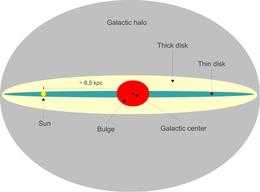Thin disk
From Wikipedia, the free encyclopedia

Edge on view of the Milky Way with several structures indicated (not to scale). The Thin disk is shown in green.
The thin disk is a structural component of certain galaxies. The Milky Way's thin disk is thought to extend up to ~1 kiloparsec (3.3 kly) in the vertical axis[1] and contributes about 85% of the stars in the Galactic plane.[2] It can be set apart from the thick disc of a galaxy since the latter is composed of older population stars created at an earlier stage of the galaxy formation. Stars in the thin disk, on the other hand, are created as a result of gas accretion at the end stage of a galaxy formation.
The thin disk contains stars with a wide range of ages and may be divided into a series of sub-populations of increasing age. Notwithstanding, it is considered to be considerably younger than the thick disk.[3]
See also
- Thick disk
- Galaxy formation and evolution
- Disc galaxy
- Spiral arm
- Galactic halo
- Galactic spheroid
- Galactic corona
External links
- Astronomers identify thick disc of older stars in nearby Andromeda galaxy
- Populations & Components of the Milky Way
References
- ↑ Gilmore & Reid, 1983, "New light on faint stars. III - Galactic structure towards the South Pole and the Galactic thick disc",
- ↑ Carlos Allende Prieto (Nov 2009). "The Stellar Population of the Thin Disk". Proceedings IAU Symposium (265).
- ↑ Bensby & Feltzing, "The Galactic thin and thick discs in the context of galaxy formation",
This article is issued from Wikipedia. The text is available under the Creative Commons Attribution/Share Alike; additional terms may apply for the media files.